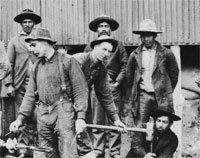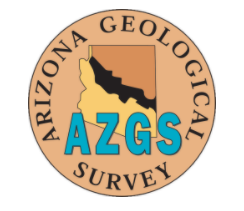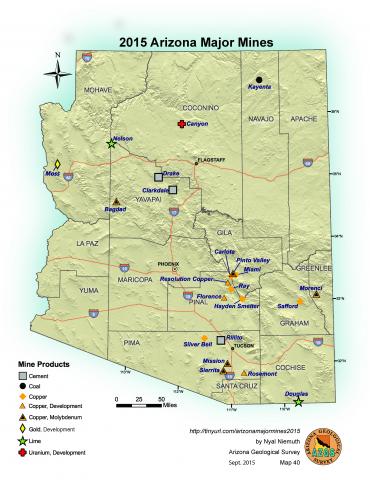Arizona is a major producer of non-fuel minerals. The future of Arizona mining rests on the following fact: each American uses more than 45,000 pounds of newly mined minerals annually!
Arizona Mining, Minerals, & Copper: A Primer
The earliest miners in what is now Arizona were Native Americans who chiefly mined surface outcrops of salt, clays, hematite, quartz, obsidian, stone, turquoise, and coal. In the late 1600s, Spanish explorers hunted for metallic deposits with especial interest in gold and silver. Antonio de Espejo made the first major silver discovery south of the San Francisco Peaks in May 1583, near what some believe is present-day Jerome, Arizona. By the late 17th Century, Spanish prospectors had engaged in extensive mining in the mountains bordering the Santa Cruz River and its tributary Sonoita Creek. Rare discoveries of sheets or “planchas” of silver – one sheet reportedly weighted 2700 pounds – fired the imaginations of several generations of miners. (Image to left: Early day miners stand in front of a mine portal near Morenci, AZ)
 In 1854, in Ajo, Arizona, the Arizona Mining and Trading Company launched the modern era of hard-rock mining. A burgeoning mining industry stimulated early growth in the Arizona Territory, and by 1864 nearly 25 percent of the male, non-native populace was prospectors. By the 1870’s a plethora of hardrock mines were yielding prodigious volumes of copper, lead, zinc, silver and gold ore. In 1912, the newly christened state of Arizona supported 445 active mines, 72 concentrating facilities, and 11 smelters with a gross value of nearly 67 million dollars — equivalent to1.4 billion dollars in 2006 dollars.
In 1854, in Ajo, Arizona, the Arizona Mining and Trading Company launched the modern era of hard-rock mining. A burgeoning mining industry stimulated early growth in the Arizona Territory, and by 1864 nearly 25 percent of the male, non-native populace was prospectors. By the 1870’s a plethora of hardrock mines were yielding prodigious volumes of copper, lead, zinc, silver and gold ore. In 1912, the newly christened state of Arizona supported 445 active mines, 72 concentrating facilities, and 11 smelters with a gross value of nearly 67 million dollars — equivalent to1.4 billion dollars in 2006 dollars.
Metallic Commodities
The important metallic commodities of Arizona, listed in order of decreasing value, include copper, gold, silver, molybdenum, and lead. Non-metallic (industrial) minerals produced — listed in order of decreasing value — include sand and gravel, crushed stone, clay, cement, gypsum, lime, perlite, pumice, and salt. Arizona’s is world-famous for its turquoise, peridot, petrified wood, azurite, and malachite; turquoise, azurite and malachite are copper-bearing minerals. Arizona also produces energy resources such as coal and small quantities of petroleum and natural gas.
Arizona’s Metallic Mining Districts
Mining districts in Arizona are categorized by the specific geologic environment in which the mineral deposit formed – see the accompanying mineral resource map. Base- and precious-metal mining districts are classified by the dollar value of metals produced. Only those metallic mining districts with total reported values greater than $500,000 (based on 1996 metal prices) in the production of copper, lead, zinc, gold, or silver are shown. Manganese, uranium, and tungsten districts have had significant production. Iron and mercury mineral districts yielded minor quantities. Locations of economically or historically significant mines appear on the mineral resource map.
A northwest-trending belt of metallic mineralization across the state is a striking feature on the map. The southeastern part of this belt is dominated by porphyry copper (red on map) and associated lead, zinc, gold, and silver deposits (blue and purple on map). These deposits are largely associated with granitic rocks intruded 70 to 55 million years (m.y.) ago. A number of important deposits in central Arizona are associated with Precambrian (1,750 to 1,650 m.y. ago) volcanic rocks. The western end of the belt is dominated by gold deposits (orange on map), mostly related to volcanic activity between 25 and 15 m.y. ago.
In addition, economically significant uranium deposits (light blue on map) are concentrated in northeastern Arizona. Locations from which a commodity has been produced are designated by stars. Arizona is believed to have potential for undiscovered metallic, non-metallic, and other resources, including oil and gas, coalbed methane, helium, carbon dioxide, and geothermal.
Select Mine & Mineral Resources
- Directory of Active Mines in Arizona – 2020
- History of the Christmas Mine, Gila County, Arizona
- Directory of Active Mines in Arizona: FY 2019
- Metallic Mineral Districts – Map & Report
- Copper Oxide Resources of Arizona
- Arizona Major Mines Map 2015
- Arizona Mine Index – Metallic Mineral Mines
- Geology & Mineral Resources of Arizona






